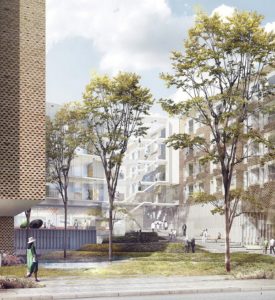In 2010, the Danish healthcare system sent a study team to the United States to visit best-of-class hospitals and observe best practices in facilities design. The team’s U.S. tour was part of the system’s initiative to renew and expand Denmark’s aging facilities and improve the quality of care as there had not been any significant, new hospital development in the last 30-40 years. Among the contacts they made during their visits was a group of medical planners and designers from EYP Health (formerly WHR Architects).

Those initial meetings revealed a mutual interest in developing a new international model for healthcare facilities that would leverage not only U.S. expertise and resources, but also the strengths of leading thinkers and designers from many critical disciplines across multiple countries, including Denmark. In the following years, the design firm committed to competing in three project competitions in the Capital Region, winning two, and established a permanent presence in Copenhagen.
In Denmark, large hospital construction projects are awarded through a series of design competitions along with the traditional qualifications. The process is rigorous, for both the client and the competitors. The Bispebjerg competition was outlined in a 150-page brief citing the site’s national historic significance, the local master plan and the client’s principles for the hospital and its departments, as well as the more technical needs as far as technological, structural and facility operations. Of the 47 teams that were prequalified, seven were shortlisted for the first stage of the competition. Each team submitted eight boards and a brief of their design solution. The jury selected three firms to move into the second stage, which consisted of three interviews with the jury. In November of 2015, the consortium consisting of WHR Architects, KHR Arkitekter and Arup International Ltd. were named the winning team.
Now, one year after winning the competition, the project is providing the U.S. and Danish consortium the opportunity to test design solutions that balance innovation, best practices and cultural sensitivities in a new building as a part of a historic healthcare campus. While the specifics of the commission drove the competition design, the ongoing interactive knowledge exchange among the team members, hospital staff and future users have generated hybrid solutions that reflect the rethinking of assumptions on all sides.
The design of the patient room is a prime example of the team’s drive to be innovative and forward thinking about what the new hospital standard will become. Today, most Danish patient rooms are semi-private models that serve two or more patients in one room. Having seen the benefits of private rooms—privacy, safety and better outcomes —the government mandated that all new facilities contain primarily private rooms. With this mandate, the Danish government recommended a standard patient room layout, which was given to all of the ongoing hospital competitions.
Even now, the planning team continues to explore a design that offers an improved patient experience and greater flexibility. Today, they are creating a full-sized mock-up patient room, which will allow them to test their assumptions and receive real-time feedback from patients and staff.
The new private room model retains a Danish typical single-loaded corridor mandated by the local master plan, but trades nested toilets for inboard toilet location. The team anticipates that the corridors will create better interior spaces for improved connectivity and will allow for exterior facades to be more dynamic in the landscape. The new layout also reorients the patient to give them better viewing angles to the gardens while giving the staff improved sightlines from the corridor to the patient’s head. Large canted windows also provide sun and privacy screening while still maintaining their operability to provide fresh air.
While many European countries mandate access to daylight for their staff, Denmark has one of the strictest, requiring direct access to daylight and a view to the horizon for anyone working longer than three hours in a space. As a result, the typical floorplans of Danish hospitals have exceptionally long and inefficient configurations to maximize access along window walls.
Reconfiguring the hospital plan around a series of courtyards not only creates multiple opportunities for daylight access and views, but improves overall connectivity for patients and staff. With clear separation between staff and public circulation, this design not only makes wayfinding easier, but also provides for shorter corridors for an improved circulation path to decrease walking distances and improve efficiencies.
Instead of crowded, decentralized waiting areas immediately adjacent to treatment areas, the Bispebjerg design consolidates much of the waiting area along a well-connected “lobby loop” that encircles the courtyards at center of the building. This design creates a clear wayfinding approach that offers ample opportunities to see the gardens and artwork on the interior and exterior for all occupants. The waiting areas, which are an integral part of this pathway, are divided into five different types for varying activities—family zones, working zones, knowledge/library zones, quiet reflection zones and general waiting. Each provides a comfortable waiting area that not only offers views to outside and natural light, but will help pass the time for visitors and patients.
The team’s goal was never to design an American hospital for the people of Copenhagen, but to blend the best Danish healthcare practices with the best international practices to create a state-of-the-art healthcare standard everyone can benefit from. And, as the team continues to refine its design solutions with the client and users, the lessons learned are being applied not just in the design of Bispebjerg, but on other projects in the United States. Knowledge transfer is always a two-way street.
Editor’s note: Stay tuned for the March/April issue of MCD, which explores healthcare projects around the globe.





